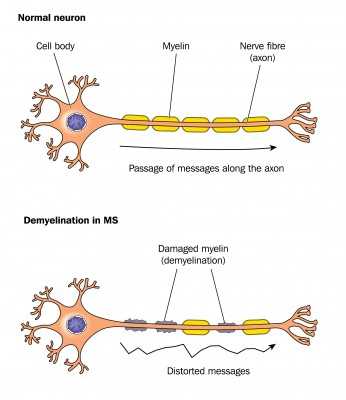Demyelinating Disorder
Demyelinating disorders interfere with the ability of nerve cells to transmit information. Nerve cells, also known as neurons, are normally surrounded by a protective fatty coating called myelin. Myelin surrounds nerve fibers in both the central and peripheral nervous system, and acts much like the coating on an electrical wire. The myelin sheath both protects the neuron and speeds up the transmission of neural impulses.When the myelin sheath surrounding the neurons is damaged, nerve transmission is compromised. Neurons without myelin can only transmit signals at a speed of one metre per second, compared to the hundred metres per second of healthy myelinated neurons.
In addition to sending slower signals, nerves that have been stripped of their myelin coating may degenerate. This can result in a variety of neurological symptoms, including blurred or double vision, fatigue, clumsiness, numbness, hand paralysis, impaired muscle coordination, weakness, dizziness, loss of sensation, unsteady gait, and pain. Symptoms vary depending on the cause and location of the demyelination.
Demyelination disorders are often the result of a pre-existing disorder. Myelin can be damaged as a result of viral infections, inflammation, lack of oxygen supply, metabolic problems, or compression of nerves. Demyelination diseases can often be categorized into one of these groups, which indicate their original cause. However, not all demyelinating disorders fit neatly into this framework. Many disorders occur as a result of several of these factors, and not all demyelinating disorders have a known cause.
Those of unknown origin are called primary demyelinating disorders. Some primary demyelinating disorders include Optic Neuritis, Acute Transverse Myelitis, Acute Disseminated Encephalomyelitis, and Acute Hemorrhagic Leukoencephalitis. It is believed that these primary disorders may be triggered through an autoimmune mechanism. However, further research is required before this can be concluded.
Multiple Sclerosis is the most common demyelinating disorder. In Multiple Sclerosis, myelin in the brain and the spinal cord degenerates and is replaced by scar tissue. Multiple Sclerosis has been linked to both inflammatory processes and to viral infection. Canada has a higher incidence of Multiple Sclerosis than many other countries, which may be related to its high latitude. Because of the low concentrations of sunlight, Canadians often have low levels of vitamin D, which is thought to reduce inflammation.
The demyelination that occurs in most of these disorders tends to be segmental or patchy, and can affect multiple regions either simultaneously or sequentially. Remyelination can often occur, and individuals can experience repair, regeneration, and complete recovery of neural function. However, if extensive myelin loss takes place, this can trigger axonal and cell body degeneration which are usually irreversible.
No cure currently exists for demyelinating diseases, but there are some treatments which focus on decreasing the body’s immune response. Both physical therapy and medications are often used to manage symptoms. Vitamin D is also thought to be a possible option for treatment or prevention.

Normal neuron nerve cell and demyelinated neuron in multiple sclerosis
Sources:
“Pathology of Primary Demyelinating Diseases.” Available on: http://brain101.info/Primary_Demyelinating_Diseases.pdf
“Transverse Myelitis.” Available on: http://www.uptodate.com/contents/transverse-myelitis
“Demyelination: What Is It and Why Does It Happen?” Available on: http://www.healthline.com/health/multiple-sclerosis/demyelination#Overview1
“Demyelinating Diseases.” Available on: http://www.ncbi.nlm.nih.gov/pmc/articles/PMC1860500/
“What are the types of demyelinating disease that affect the CNS and what can you do about them?” Available on: http://www.mayoclinic.org/demyelinating-disease/expert-answers/faq-20058521/
